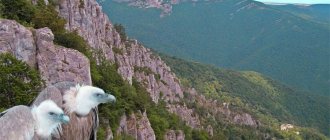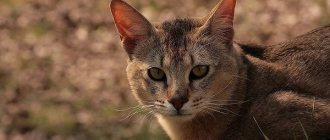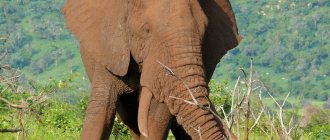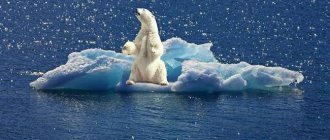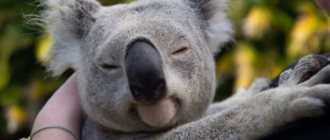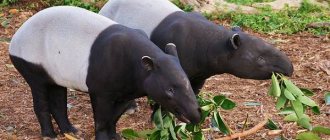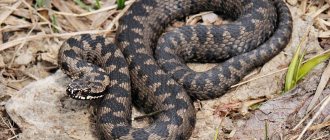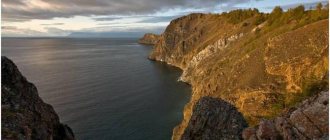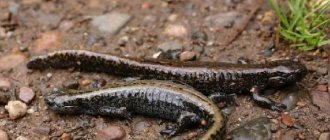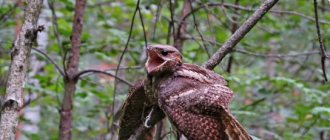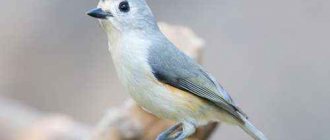The Urals is a region of the Russian Federation, most of which is occupied by a system of mountain ranges called the Ural Mountains. They stretch for 2,500 kilometers, as if dividing the country into European and Asian parts. By the way, this is where the unofficial border between Europe and Asia passes, as evidenced by numerous signs on the roads.
The nature in the Urals is extremely diverse. There are steppes, serious heights, river valleys, and also majestic forests. The fauna matches the environment. Here you can find both the red deer and the garden dormouse.
Reindeer
This animal belongs to the artiodactyl mammals. Only in this species the females wear horns in the same way as the males. They move without problems on the snowy surface, thanks to their wide hooves.
Deer have excellent hearing. But their vision leaves much to be desired. In reindeer herds, primacy belongs to the leader. In the winter season, animals get food from under the snow.
At other times of the year, reindeer feed on mushrooms, algae, bird eggs and sea water. It is impossible to make a reindeer as a pet. Even if you manage to do this, you need to make every effort to care for it.
Otherwise, this freedom-loving animal may turn wild again. In the Northern regions, wealth is measured not in money, but in the presence of reindeer. The more of them, the richer the person is considered.
Pictured are reindeer
Hoofed lemming
This mammal belongs to the hamster family. The lemming is of medium size. The tail is no longer than the hind feet. There is lint on the animal's paws. These animals live in a variety of places.
Their diet includes leaves and tree bark. Rodent activity is constant. They are always awake. The homes of these animals have a complex structure; they have more than one entrance and exit.
This is what their burrows look like. For the winter period, lemmings equip warm nests covered with wool. For each season of the year, animals have their own original colors. In winter they are pure white and light fawn.
In the summer they turn red or brown. They have a clearly visible black stripe along their back. Their neck is crowned with a barely noticeable light necklace. Young lemmings can be distinguished in spring by their creamy tones.
In the photo there is a lemming
Arctic fox
This wonderful animal belongs to the fox family. They are small and fluffy. Arctic foxes grow from 45 to 70 cm in length. Their weight does not exceed 8 kg. Arctic foxes have fluffy white fur, which reliably protects them from severe frosts, because the habitat of these animals is in the northern hemisphere, where temperatures remain constant below zero.
The diet of arctic foxes includes food that they find themselves. There are times when there is practically no food. Then they find the leftovers of large predators and eat them with pleasure. These amazing animals live in places that, according to people, are absolutely unsuitable for life.
Animal arctic fox
Fauna of the Sverdlovsk region - list, characteristics and photos
Photo: CopperKettle/Wikimedia Commons
The Sverdlovsk region is located in the very center of the Urals. The peculiarities of the geographical location of the region had a significant impact on the species composition of its fauna. Since most of the territory is occupied by boreal forests, there are especially many typical taiga fauna here. In addition, an important role is played by the fact that the Urals is located at the junction of Europe and Asia, which is why the fauna of the region has a mixed European-Asian character. Let's get to know some representatives of the animal world of the Sverdlovsk region better.
Middendorff's vole
This animal can most often be found in the tundra in the Northern Urals. The vole prefers moss swamps. Its body reaches 130 mm in length, its tail is 35 mm long. In summer, they use sedge stems for food.
In the winter season, its root part is used. This animal stores food for future use. Vole nests can be seen at a level just above the ground, in blueberry and birch bushes.
Middendorff's vole
Partridge
These creatures are absolutely not afraid of the proximity of people. On the contrary, they are trying to settle closer to populated areas. And in winter, they even look for overnight shelter in courtyards or near other people’s buildings. Partridges are slightly larger than pigeons. Females are practically no different from their males.
These are sedentary creatures. Partridges can leave their permanent habitats only due to hunger or human activity. Most of their time is spent searching for food. They don't rise very high. The flight is smooth and calm.
It is a collective creation. There are up to 30 individuals in a flock of partridges. Only in the spring do they break up into pairs. Partridge activity peaks in the morning and evening. They prefer to sit out during the day and night in bushes and thickets of tall grass.
In the photo there is a partridge bird
Geographical location of the Urals
The region is located between two plains - West Siberian and East European. In the North, the Ural Mountains reach almost to the Arctic Ocean, and in the South, they adjoin the territories of Kazakhstan.
Natural areas
Due to their extraordinary breadth and extent, these lands are usually divided into several parts, each of which is characterized by its own natural zone.
There are four in total:
- the polar one is known for its tundras and forest-tundras;
- the northern edge begins with forest-tundra and continues with taiga;
- on the lands of the Middle Urals there is taiga, below there are forest-steppes;
- finally, the southern part is characterized by steppes located below the forest-steppe areas.
As you can see, the Urals are distinguished by outstanding diversity, collecting almost all types of natural zones with the exception of deserts.
Relief and climate
The relief of the region consists of mountain ranges located parallel to each other. They are not too high (they rise at different points only up to 1600 m), with rounded or flat tops. Stone ridges lie in disarray on the peaks. Rivers flow and valleys run between the ridges.
The climate of the Urals is typical for mountainous areas. On the western side of the mountains there is more precipitation, while in the East the weather is arid and the climate here is closer to continental. Moreover, the further into the mountains, the less noticeable are the continental climate features. In the very north of the region the climate is subarctic, below it is temperate.
Hydrography
The region is famous for its abundance of rivers, which has a beneficial effect on the wealth of local wildlife. From the North, the territories cover the shores of the Arctic seas: Kara and Barents. Cold cyclones bring snowy and frosty winters here, especially along the shores of the Barents Sea, however, the ice in these places still melts in the warm season.
The rivers of the region constitute the main watershed of the Arctic Ocean, while in the western part of the mountains their channels are more complex and winding (Usa, Pechora). Eastern rivers flow from the Ob: Tavda, Tura, Iset, Tobol, etc.
The most famous of their local rivers is the Ural, which belongs to the Caspian basin.
Local rivers are fast, their banks are mostly rocky. It is the combination of deep reservoirs and green valleys that creates an excellent habitat for many species of animals.
Bear
People learn about these animals from an early age. They are the main characters of the most beloved children's fairy tales. This is the largest animal at the same time it is the least predatory.
The bear's favorite delicacy is succulent grass roots, young plant stems, berries, and cedar nuts. The bear eats fish not without pleasure. He does not disdain carrion. Sometimes, during times of famine, bears attack moose.
As for the relationship of this beast with man, he is more afraid of him than aggressive towards him. But don't relax when you see a bear. Under no circumstances should he be offended or disturbed in his den.
From a calm, half-asleep animal, he can quickly turn into an aggressive beast. Its behavior towards humans is unpredictable when the bear is hungry. At such moments it is better to avoid him.
Elk
This forest dweller inspires respect and fear with his menacing appearance. Moose are large and strong. They have tall limbs and a relatively short body. The humped muzzle and heavy horns of the males are considered by everyone to be a symbol of the taiga.
The favorite places of this animal are pine forests, old burnt areas and clearings. It is in such places that there is a sufficient amount of undergrowth. The favorite food of these wild animals of the Urals are tree branches, and they love pine trees the most. They often settle on river banks and in swamp areas. In the autumn season, moose move from west to east. They return back in the spring.
Animals of the Red Book of the Urals
As such, the Red Book of the Urals does not exist. Each region has its own Red Book. In principle, creating a general list of rare and endangered animal species for the entire Urals as a whole is not difficult, but it will add little to regional registers, and in order to provide practical assistance, you will still need to focus on local standards.
Animals of the Red Book of the Urals include bats (water bat, long-whiskered bat, pond bat, northern leather bat, etc.) and rodents (flying squirrel, garden dormouse, Djungarian hamster, forest lemming, large jerboa, gray hamster). Let's look at some types in more detail.
Common hedgehog
This representative of the order of insectivorous animals is listed in the Red Book of the Sverdlovsk Region. These animals eat a lot of insects and slugs, which pose a danger to both forests and garden plots.
The common hedgehog is, perhaps, one of the few animals that allows humans to come within very close range. But this happens not at all because the hedgehog is a brave fellow, but because of his poor eyesight. Therefore, hedgehogs prefer to rely on their sense of smell. But their nose often fails them: if the wind blows in the opposite direction, these animals are not able to smell the approach of a person or animal.
These insectivores hunt at night. When hunting, the common hedgehog is a dexterous and agile animal. The animal not only destroys harmful insects, but is also not averse to feasting on poisonous snakes. By the way, viper venom has practically no effect on the common hedgehog.
Despite its thorns, the hedgehog cannot boast of complete protection from enemies, of which it has plenty: large owls, eagle owls, hawks, foxes and, of course, the man who did everything to ensure that the population of this insectivore was in danger of extinction.
Muskrat
The human factor, namely human greed, is the reason why these animals are on the verge of extinction. When their population was at its proper level, muskrats were exterminated en masse because of their beautiful and valuable fur. Breeding muskrats for the same purpose contributed to the displacement of muskrats from their natural habitats.
steppe cat
This animal is assigned not too dangerous category No. 3 in the Red Book of the Orenburg Region. The prey of steppe cats is birds and small rodents. The winter period, as you know, is a difficult time for the wild animals of the Urals. Steppe cats, for lack of prey, can wander into a person’s home to profit from, for example, chickens.
Hare
There's no big need to tell everyone who it is. Just like the bear, fox and wolf, the hare is a painfully familiar specimen. Everyone's favorite cartoon, “Well, wait a minute!” introduces children to it from an early age.
White hares live in the Urals. They prefer places where there is a lot of young undergrowth, clearings and burning areas. Animals take rest wherever they can. This could be a bush or a leaning tree. That is why the animal can often jump out suddenly, it seems almost from under your feet.
↑ Attractions
People come to the Urals specifically to look at the famous wonders of the Ural nature:
- weathering pillars on the Manpupuner Plateau;
- Kapova Cave, where ancient rock paintings are preserved;
- underwater gypsum Orda cave;
- Kungur Ice Cave;
- the Chusovaya River and Mount Narodnaya;
- walk around the Taganay National Park and visit many other places.
Tourists come to admire the main attraction, the Nugush Reservoir, calling the reservoir “Mountain Tale”, “Pearl of Bashkiria” and “Sea of 3 Cities”. Mount Sumoyak is loved by psychics; they climb here to get a boost of energy and strength.
Wolf and fox
The wolf and the fox are fairly well-known predators of the forest. Foxes love to live in sparse forests, along rivers, and near human settlements. This red-haired predatory beauty prefers to eat birds, rodents, insects and frogs.
Sometimes hares become victims of foxes. But this doesn't happen as often as people say. As for the wolf, it is a much more serious predator. Its victims are wild ungulates. The wolf prefers elk and deer.
Most often it attacks them when they are unhealthy and weakened. Wolves never refuse food from hares, foxes and small mice. In the winter season, these animals unite in packs and pose a great danger to humans, although there are isolated cases of their attacks on people.
Birds
The avifauna of the Sverdlovsk region includes 228 species of birds. In quantitative terms, dendrophiles predominate - a group of arboreal and shrubby birds, confined to forests of various types and bushes. The most numerous species are the following: white-browed finch, brown-headed chickadee, wood grouse, common redstart, song thrush, robin, chaffinch, garden warbler, wood pipit, green warbler, willow warbler, chiffchaff, common quail, gray warbler, black grouse, lentil ordinary.
The composition of the nesting avifauna, in quantitative terms, is also dominated by birds associated with trees and shrubs: northern warbler, woodcock, hooded crow, spotted thrush, redwood woodpecker, spotted woodpecker, three-toed woodpecker, field lark, wood accentor, common crossbill, spotted pipit , yellow-headed kinglet, corncrake, deaf cuckoo, common cuckoo, barn swallow, Muscovy, gray flycatcher, common bunting, bunting, green mockingbird, common nuthatch, fieldfare, hazel grouse, common cricket, great tit, long-tailed tit, garden warbler, slav ka - Accentor, common bullfinch, mint, stonechat, lapwing, siskin; The following species are also numerous, confined to aquatic and semi-aquatic biotopes: snipe, badger warbler, mallard, carrier, river cricket, white wagtail, mountain wagtail, and black duck.
The common kingfisher stops during migration on the Pyshma River, where it hunts for fish from the air.
Rare are: shorebird, golden eagle, field sparrow, little funnel, jackdaw, ruffed goldeneye, common goldeneye, white-backed woodpecker, common crane, black kite, white-winged tern, common tern, merganser, marsh harrier, little flycatcher, tawny owl, sparrowhawk, wigeon, short-eared owl, jay, goshawk, grasshopper, yellow wagtail, gray duck, gray heron, tufted duck, pintail.
34 species of birds of prey have been recorded in the region, including 23 species of diurnal predators: saker falcon, golden eagle, merlin, rough-legged buzzard, falcon, black kite, gyrfalcon, marsh harrier, meadow harrier, field harrier, steppe harrier, imperial eagle, white-tailed eagle, common buzzard, sparrowhawk, greater spotted eagle, common kestrel, peregrine falcon, osprey, goshawk, hobby hobby, black vulture; and 11 nocturnal predators: great gray owl, gray owl, Ural owl, white owl, short-eared owl, long-eared owl, hawk owl, scops owl, short-footed owl, sparrow owl, eagle owl.
The following species of birds are included in the Red Book of the Sverdlovsk Region: bittern, merlin, gray woodpecker, black-throated accentor, common kingfisher, falcon, curlew, tundra partridge, whooper swan, mute swan, meadow harrier, lutok, great gray owl, gray owl , dipper, common buzzard, hawk owl, scops owl, sparrow owl, yellow-fronted wagtail, common scoter, crystal.
Wolverine
This animal is a large predator. He has large paws and a rather fluffy tail. The carcasses of elk and reindeer are the most favorite food of wolverines. Sometimes they attack these animals.
This happens if they are sick. Otherwise, Wolverine will not be able to defeat them. Rodents, game and small foxes are also used. It is not important for these animals to live in any particular place. They can travel long distances in search of food.
In the photo there is a wolverine
Lynx
This wonderful northern cat is known to many. It is easy to recognize by the tassels on its ears, sideburns and small tail. The weight of an adult lynx is about 25 kg. The color of the animal is reddish-brown or pale-smoky.
The vigilance and sensitivity are enviable. In addition, she has excellent hearing. A lynx can detect the sound or footsteps of a prey several kilometers away, but will not attack immediately.
At first she sneaks up cleverly and cunningly. For hunting he chooses the dark time of day. The height of this animal is equal to the height of two adults. The lynx's main food is field mice.
She does not refuse the hare, black grouse and artiodactyls. Sometimes, when this animal appears in a populated area, cats or dogs may suffer from the lynx.
May attack a fox. But not in order to eat it, but simply for the sake of prey. Lynx needs two kilograms of meat per day. This beautiful wild cat is not afraid of humans.
How to get to Olenyi Ruchi Park?
You can get there by rail in four hours.
There is a train from Yekaterinburg to Druzhinino station. Upon arrival, transfer to the commuter train to the Mikhailovsky Plant, which runs twice a day, and go to the Bazhukovo stop.
By bus you can get there in two and a half hours. Take any commuter bus to Mikhailovsk, Urmikeevo, Arti, Tulgash and go to the Olenyi Ruchi stop.
Then you have to walk 2 km. There is a parking lot at the entrance to the park, so you can also drive here with your own vehicle.
Sable
This taiga resident differs from many animals in his agility and strength. Lives on the ground. Moves by jumping. At the same time, sables are excellent at moving through trees.
They have well-developed hearing and sense of smell. This cannot be said about vision; the sable cannot boast of it. This animal makes a cat-like purr. Moves easily on loose snow.
The animal is active in the morning and evening. His favorite habitats are cedar trees, headwaters of mountain rivers, dwarf elfin thickets, and rocky outcrops. Only occasionally can you see a sable in the crown of a tree. They prefer to hunt alone. Most of all, they don’t like to see stoats on their lands.
The animal in the photo is sable
Animals of the Southern Urals
Forest, steppe and tundra vegetation zones are combined here. The rich world of flora of the Southern Urals has allowed small and rare animals to survive in this territory. In particular, this is where representatives of the steppe zones live: voles, gophers, jerboas, hamsters, and steppe marmots.
Animals of the Southern Urals are represented by wolverines, brown bears, squirrels, arctic foxes, sables, hazel grouse, wood grouse, horned larks and even reindeer. It’s hard to believe, but the horned representative of the Subpolar Urals migrated to the southern region following the movement of vegetation.
Brown bear
These animals are found everywhere here, but, fortunately, it is quite rare to see them. The weight of an adult male varies from 3 to 5 centners. In general, the bear is a common representative of the fauna world not only among the animals of the Southern Urals, but also among the entire animal world of the Urals .
By the way, it’s hard to call a bear a predator. The fact is that these furry heavyweights are omnivores: they eat meat and fish, as well as honey and wild berries.
In the fall, brown bears gain subcutaneous fat and hibernate. Bears that have not gained fat by autumn and have not slept for the winter become cranks. South Ural brown bears, like other brown bears, build dens on dry surfaces - under upturned tree roots.
Sable
Among the animals of this area, one can highlight the so-called “pearl of the Siberian taiga” - the sable. This animal is the national pride of Russia, since since the times of the Russian Empire it has formed the basis of the country’s fur wealth. This is a brave and dexterous predator. In one day, the animal is capable of running a huge distance of many kilometers. He readily climbs trees, but walks on the ground.
This animal hunts in different ways. He can, like a cat, sit in ambush and watch for a mouse, or he can persistently pursue a musk deer through the loose snow until it is exhausted. The main diet of the sable is small rodents. The sable often hunts large birds, fish, squirrels and even its smaller relatives - the ermine and the weasel. The sable also eats lingonberries, blueberries, rowan berries, and pine cones.
Marten
She has a beautiful slender body, 50-80 cm in length. The length of the animal's fluffy tail is 35-50 cm. They weigh from 0.5 to 5.7 kg. Males are usually larger than females. Martens have a brown-brown color.
These are agile animals that can perform any acrobatic trick. Little martens spend most of their free time playing. They never attack humans.
But if the marten, its home or children are threatened, they become monstrously aggressive. They use sharp teeth and claws of animals, which can cause great harm.
Beaver
This animal is the largest rodent in all of Russia. Can live both in water and in a hole. Thanks to its unique swimming membranes, the beaver feels great in the water.
It has a flat, hairless, plate-covered tail. In order to protect their burrows from the encroachments of others, beavers build dams. They consist of branches and trees.
Such dams can be up to 15 meters wide and block the flow of water to such an extent that it rises up to 1.5 meters. These animals feed on branches of willow, bird cherry, birch and aspen. In summer, grass comes into play.
↑ Essay on the nature of the Urals
The nature of the Ural region is amazing and beautiful, unlike other places. There are stunningly beautiful rivers, forests and lakes in their original form, which are admired by artists and poets. The Ural Mountains keep many secrets; stories and legends are written about them.
Bazhov's Tales about the Mistress of the Copper Mountain are well known. The legend of how the precious stones were found. The Ural Mountains, called the Stone Belt in ancient times, lie many kilometers across Russia. A young man named Ur, which means “Earth,” saw and fell in love with a girl. That girl had long golden hair and shiny clothes, named Al, which means gold. And so they began to live, together Ur and Al.
There are many clean lakes, rivers, waterfalls and mysterious caves in the Ural Mountains. No other region of Russia has as many lakes as the Urals. “Blue Necklace of Russia”, “Land of Lakes” - this is how the territory of the Southern Urals is called. Unusually clean picturesque rivers carry their waters through beautiful valleys between high mountains.
The Urals are proud rocks and strict mountain ridges, the welcoming blue of lakes and the menacing roar of waterfalls, impenetrable forests and steppes without end and without edge. This is the only place on the planet.
Otter
She has one of the most valuable furs. From many descriptions of animals in the Urals , it is known that the number of otters has noticeably decreased. They are near-aquatic predators, so their burrows can be seen right next to the water.
Sometimes they rent beaver and muskrat holes. They lead a sedentary lifestyle provided they have something to eat. If the food supply deteriorates, they look for more nourishing places and migrate there.
The otter prefers exclusively animal food. Loves fish, frogs, crustaceans, insects, birds. This animal has practically no natural enemies or competitors.
The animal in the photo is an otter.
The fauna of the Urals is so interesting and rich that you can talk about it with passion and endlessly. Not everyone has the opportunity to visit this wonderful and fabulous corner. Photos of animals of the Urals will help , in which they look almost the same as in real life.
↑ Description of the nature of the Urals
The nature of the Urals is divided into Polar, Subpolar, Northern, Middle and Southern zones. The zones differ from each other in climate, relief, and composition of flora and fauna. The Arctic, Northern and Southern regions rise above 1500 m.
Mount Jurma photo
There are many lakes in the mountains, and deep river valleys in the foothills. Soils: from tundra-gel layer to southern chernozems. Many forests. Ridges are a barrier to some plants and animals. Mountains also act as a barrier to the flow of air masses, regulating the climate.
Precipitation, blocked by mountain ranges, remains on the western side, where it is humid and warm. The eastern side is dry with a continental climate. Winters are frosty and snowy, summers are not hot.
